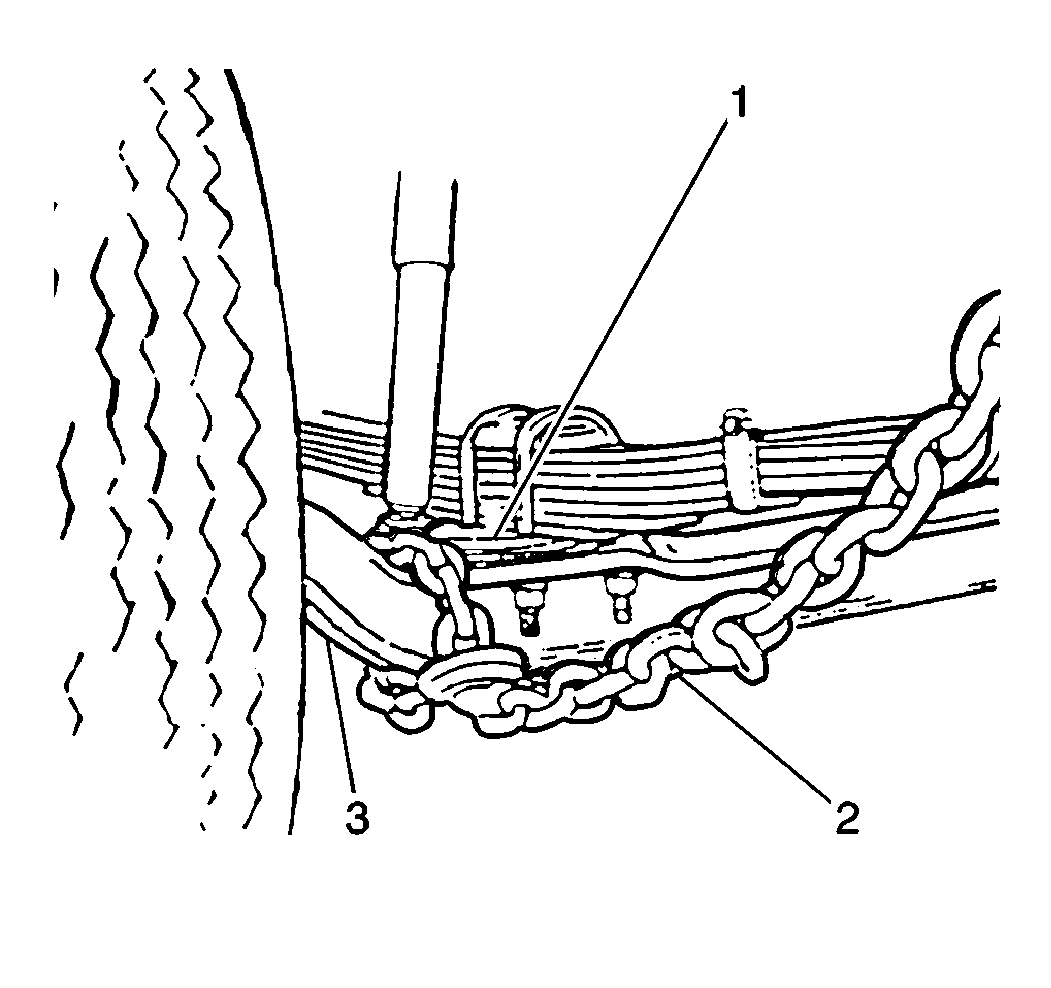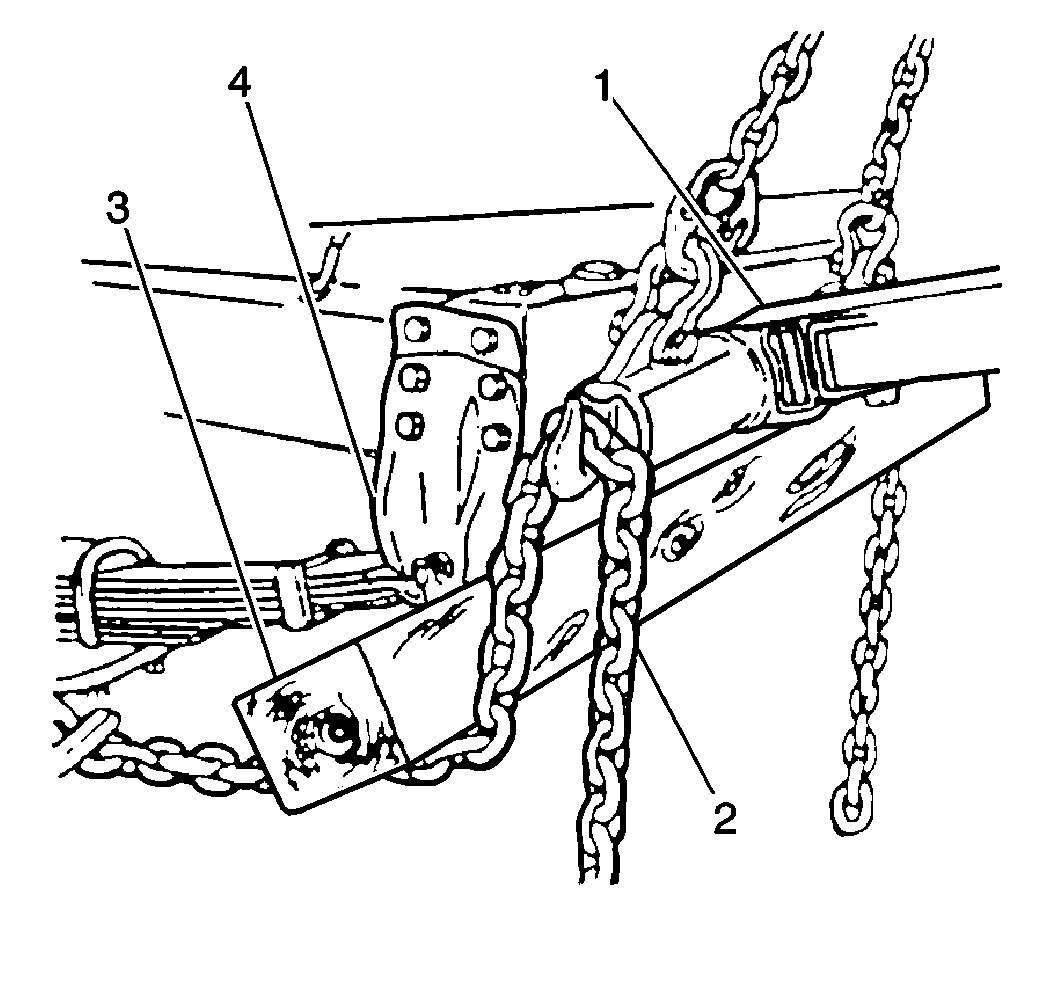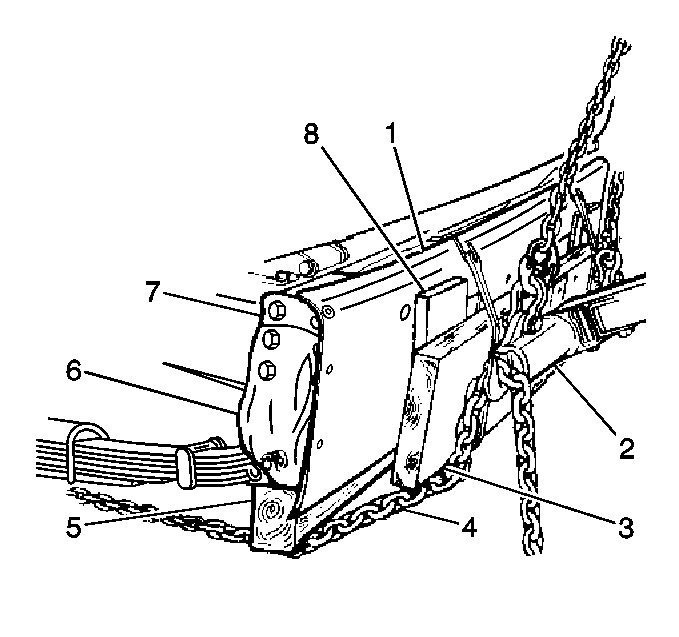When towing a Medium Duty Truck, take the following precautions
in order to prevent damage to the vehicle:
| • | Use a GM dealer or a professional towing service in order to tow
a disabled Medium Duty Truck. |
| • | Follow state and local laws that apply to vehicles in tow. |
| • | Do not tow vehicles at speeds over 90 km/h (55 mph). |
| • | Connect the towing components to the main structural parts of
the vehicle. |
| • | Do not attach towing components to the following parts: |
| • | Only use equipment designed for towing. |
| • | Follow the instructions given by the tow truck manufacturer. |
| • | Use a safety chain system. |
Front End Towing (Front Wheels off the Ground)
Before Towing
Block the rear wheels of the disabled vehicle. On vehicles with air
brakes, release the parking brake system by compressing the brake chamber
springs. Refer to Air Brake Chamber Replacement - Front
or Air Brake Chamber Replacement - Rear
in Air Drums. Releasing the parking
brake system prevents the parking brake from engaging while the vehicle
is in tow.
On vehicles with hydraulic brakes, release the parking brake fully by
moving the lever handle to the fully released position.
Vehicle Towing with the Front Bumper Removed
- Remove the front bumper.

- Connect and lock the lift
chains (2) to the front axle (3), outside of the spring anchor plates (1).

- Place an oak beam (3),
1.52 m x 15.2 cm x 15.2 cm
(5 ft x 6 in x 6 in), underneath
and slightly behind the front spring shackle brackets (4).
- Connect the lift chains (2) to the tow bar (1).
- Raise the tow bar until the lift chain cinches up and the oak
beam seats fully against the spring shackle brackets.
- Raise the vehicle to the required height.
- Prepare the axles. Refer to Preparing the Axles before Towing
the Vehicle in this section.
To Tow a Vehicle with the Front Bumper Installed

- Connect and lock the lift
chains (2) to the front axle (3), outside of the spring anchor plates (1).

- Place an oak beam (4)
underneath and slightly behind the front spring shackle brackets (5).
- Connect the lift chains (3) to the tow bar (1).
- Take up the slack in the chains until the tow bar is within four
inches of the front bumper facing (7).
- Place a 5 cm x 30.5 cm (2 in x 12 in)
oak boards (2) with rubber pads (6) against the front bumper.
- Secure the board.
- Remove the remaining slack in the lift chains. The tow bar swing
arm should rest against the 2 inch by 12 inch oak board.
- Raise the vehicle to the required height.
- Prepare the axles. Refer to Preparing the Axles Before Towing
the Vehicle.
Preparing the Axles Before Towing the Vehicle
Single Drive Rear Axle
- Remove the rear axle shafts. Refer to
Rear Axle Disassemble
in Rear Drive Axle.
- Cover the hub opening in order to prevent loss of the lubricant
or lubricant contamination.
After Towing
- Block the rear wheels and install the axle shafts. Refer to
Rear Axle Disassemble
in Rear
Drive Axle.
- Install the propeller shafts, and inspect the universal joints
for proper phasing. Refer to one of the following procedures in Driveline/Axle:
| - | Propeller Shaft Replacement - One Piece - Flange Type |
| - | Propeller Shaft Replacement - One-Piece - Yoke Type |
| - | Propeller Shaft Replacement - Two Piece - Flange Type |
| - | Propeller Shaft Replacement - Two Piece - Yoke Type |
| - | Propeller Shaft Replacement - Three Piece - Flange Type |
| - | Propeller Shaft Replacement - Three Piece - Yoke Type |
- Apply the parking brake before disconnecting a Medium Duty Truck
from the towing vehicle.
- Check and fill the rear axles with oil as required.
Front End Towing (All Wheels on the Ground)
You may tow the vehicle on all wheels, provided that the steering is
operable. The power brakes and power steering will not have power assist.
Vehicles with air brakes will not have braking capability. Ensure that
there is a tow bar between the towing vehicle and the disabled vehicle.
Before Towing
| • | Block the wheels of the disabled vehicle. |
| • | On vehicles with air brakes, release the parking brake system
by compressing the brake chamber springs as outlined in Air Brakes. Releasing
the parking brake will prevent the parking brake from engaging while in
tow. |
| • | Disconnect the propeller shaft at the rear axle (forward unit
on tandem axles). Refer to one of the following procedures in Driveline/Axle: |
| - | Propeller Shaft Replacement - One Piece - Flange Type |
| - | Propeller Shaft Replacement - One-Piece - Yoke Type |
| - | Propeller Shaft Replacement - Two Piece - Flange Type |
| - | Propeller Shaft Replacement - Two Piece - Yoke Type |
| - | Propeller Shaft Replacement - Three Piece - Flange Type |
| - | Propeller Shaft Replacement - Three Piece - Yoke Type |
| • | Secure the propeller shaft to the frame or the crossmember. |
| • | If there is damage or suspected damage to the rear axle, remove
the axle shafts. Refer to
Rear Axle Disassemble
. |
| • | Cover the hub openings in order to prevent loss of lubricant or
lubricant contamination. |
After Towing
| • | Install the propeller shafts and check for proper phasing of the
universal joints. Refer to one of the following procedures in Driveline/Axle: |
| - | One-Piece Propeller Shaft Replacement |
| - | Two-Piece Propeller Shaft Replacement |
| - | Three-Piece Propeller Shaft Replacement |
| • | Apply the parking brake before disconnecting from the towing vehicle. |
Rear End Towing (Rear Wheels Off the Ground)
Before Towing
| • | Secure the steering wheel in order to maintain a straight-ahead
position. |
| • | Ensure that the front axle is not loaded above the front axle
Gross Axle Weight Rating (GAWR). |
| • | The GAWR is located on the Vehicle Certification Label. |
After Towing
| • | Block the rear wheels and release the steering. |
| • | Apply the parking brake before disconnecting from the towing vehicle. |
| • | Inspect the fluid level in the rear axle. |
| • | Fill the axle fluid as necessary. |
Special Towing Instructions
| • | Call a local GM dealer or professional towing service. |
| • | Follow all the state and local laws regarding towing: |
| • | Do not tow any vehicle over 90 km/h (55 mph). |
| • | If a vehicle is damaged, secure any loose or protruding parts
prior to towing. |
| • | Use a safety chain system that is completely independent of the
primary lifting and towing attachment. |
| • | Do not go underneath a raised vehicle unless the vehicle is supported
by safety stands. |
| • | Do not perform any towing operation that may risk the safety of
the tow truck operator, bystanders or other motorists. |




